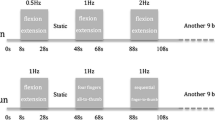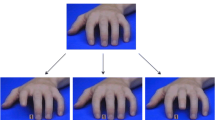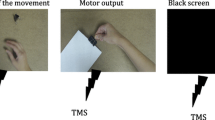Abstract
Action observation and execution activate regions that are part of the motor and mirror neuron systems (MNS). Using functional magnetic resonance (fMRI), we defined the presence and extent of MNS activation during three different motor tasks with the dominant, right-upper limb in healthy individuals. The influence of the modality of task administration (execution, observation, observation and execution) was also investigated. fMRI scans during the execution (E) of a motor task, the observation (O) of a video showing the same task performed by another person and the simultaneous observation and execution (OE) of the task were obtained from three groups of healthy subjects (15 subjects per group) randomized to perform: a simple motor (SM) task, a complex motor (CM) task and a finalistic motor (FM) task. Manual dexterity was assessed using the 9-hole peg test and maximum finger tapping frequency. MNS activation was higher during FM than SM or CM tasks, independently from the modality of administration (E, O, or OE). Inferior frontal gyrus recruitment was more significant during SM than CM tasks in the E and O conditions. Compared to SM and FM, CM task resulted in increased recruitment of brain regions involved in complex motor task performance. Compared to O and E, OE resulted in the recruitment of additional, specific, brain areas in the cerebellum, temporal and parietal lobes. The modality of administration and the type of task modulated MNS recruitment during motor acts. This might have practical implications for the set-up of individualized motor rehabilitation strategies.




Similar content being viewed by others
References
Agnew, Z. K., Wise, R. J., & Leech, R. (2012). Dissociating object directed and non-object directed action in the human mirror system; implications for theories of motor simulation. PloS one, 7, e32517.
Bellelli, G., Buccino, G., Bernardini, B., Padovani, A., & Trabucchi, M. (2010). Action observation treatment improves recovery of postsurgical orthopedic patients: evidence for a top-down effect? Archives of Physical Medicine and Rehabilitation, 91, 1489–1494.
Biagi, L., Cioni, G., Fogassi, L., Guzzetta, A., & Tosetti, M. (2010). Anterior intraparietal cortex codes complexity of observed hand movements. Brain Research Bulletin, 81, 434–440.
Buccino, G. (2014). Action observation treatment: a novel tool in neurorehabilitation. Philosophical Transactions of the Royal Society Of London. Series B, Biological Sciences, 369, 20130185.
Buccino, G., Binkofski, F., Fink, G. R., Fadiga, L., Fogassi, L., Gallese, V., et al. (2001). Action observation activates premotor and parietal areas in a somatotopic manner: an fMRI study. The European Journal of Neuroscience, 13, 400–404.
Buccino, G., Lui, F., Canessa, N., Patteri, I., Lagravinese, G., Benuzzi, F., et al. (2004a). Neural circuits involved in the recognition of actions performed by nonconspecifics: an FMRI study. Journal of Cognitive Neuroscience, 16, 114–126.
Buccino, G., Vogt, S., Ritzl, A., Fink, G. R., Zilles, K., Freund, H. J., et al. (2004b). Neural circuits underlying imitation learning of hand actions: an event-related fMRI study. Neuron, 42, 323–334.
Buccino, G., Gatti, R., Giusti, M. C., Negrotti, A., Rossi, A., Calzetti, S., et al. (2011). Action observation treatment improves autonomy in daily activities in Parkinson's disease patients: results from a pilot study. Movement Disorders, 26, 1963–1964.
Buccino, G., Arisi, D., Gough, P., Aprile, D., Ferri, C., Serotti, L., et al. (2012). Improving upper limb motor functions through action observation treatment: a pilot study in children with cerebral palsy. Developmental Medicine and Child Neurology, 54, 822–828.
Calvo-Merino, B., Glaser, D. E., Grezes, J., Passingham, R. E., & Haggard, P. (2005). Action observation and acquired motor skills: an FMRI study with expert dancers. Cerebral Cortex, 15, 1243–1249.
Calvo-Merino, B., Grezes, J., Glaser, D. E., Passingham, R. E., & Haggard, P. (2006). Seeing or doing? influence of visual and motor familiarity in action observation. Current Biology, 16, 1905–1910.
Coynel, D., Marrelec, G., Perlbarg, V., Pelegrini-Issac, M., Van de Moortele, P. F., Ugurbil, K., et al. (2010). Dynamics of motor-related functional integration during motor sequence learning. NeuroImage, 49, 759–766.
Duvernoy HM. (1999): The human brain. Surface, blood supply, and three-dimensional sectional anatomy. NewYork: SpringerWien.
Ertelt, D., Small, S., Solodkin, A., Dettmers, C., McNamara, A., Binkofski, F., et al. (2007). Action observation has a positive impact on rehabilitation of motor deficits after stroke. Neuroimage, 36(Suppl 2), T164–T173.
Fadiga, L., Fogassi, L., Pavesi, G., & Rizzolatti, G. (1995). Motor facilitation during action observation: a magnetic stimulation study. Journal of Neurophysiology, 73, 2608–2611.
Friston, K. J., Holmes, A. P., Price, C. J., Buchel, C., & Worsley, K. J. (1999). Multisubject fMRI studies and conjunction analyses. NeuroImage, 10, 385–396.
Gazzola, V. & Keysers, C. (2009). The observation and execution of actions share motor and somatosensory voxels in all tested subjects: single-subject analyses of unsmoothed fMRI data. Cerebral Cortex, 19, 1239–1255.
Goldenberg, G. & Karnath, H. O. (2006). The neural basis of imitation is body part specific. The Journal of Neuroscience, 26, 6282–6287.
Grezes, J. (1998). Top down effect of strategy on the perception of human biological motion: a pet investigation. Cognitive Neuropsychology, 15, 553–582.
Grezes, J., Armony, J. L., Rowe, J., & Passingham, R. E. (2003). Activations related to "mirror" and "canonical" neurones in the human brain: an fMRI study. NeuroImage, 18, 928–937.
Iacoboni, M. & Mazziotta, J. C. (2007). Mirror neuron system: basic findings and clinical applications. Annals of Neurology, 62, 213–218.
Iacoboni, M., Woods, R. P., Brass, M., Bekkering, H., Mazziotta, J. C., & Rizzolatti, G. (1999). Cortical mechanisms of human imitation. Science, 286, 2526–2528.
Johnson-Frey, S. H., Maloof, F. R., Newman-Norlund, R., Farrer, C., Inati, S., & Grafton, S. T. (2003). Actions or hand-object interactions? human inferior frontal cortex and action observation. Neuron, 39, 1053–1058.
Kessler, K., Biermann-Ruben, K., Jonas, M., Siebner, H. R., Baumer, T., Munchau, A., et al. (2006). Investigating the human mirror neuron system by means of cortical synchronization during the imitation of biological movements. NeuroImage, 33, 227–238.
Leech, R., Braga, R., & Sharp, D. J. (2012). Echoes of the brain within the posterior cingulate cortex. The Journal of Neuroscience, 32, 215–222.
Lingnau, A. & Downing, P. E. (2015). The lateral occipitotemporal cortex in action. Trends in Cognitive Sciences, 19, 268–277.
Molenberghs, P., Brander, C., Mattingley, J. B., & Cunnington, R. (2010). The role of the Superior temporal sulcus and the mirror neuron system in imitation. Human Brain Mapping, 31, 1316–1326.
Molenberghs, P., Cunnington, R., & Mattingley, J. B. (2012). Brain regions with mirror properties: a meta-analysis of 125 human fMRI studies. Neuroscience and Biobehavioral Reviews, 36, 341–349.
Newman-Norlund, R., van Schie, H. T., van Hoek, M. E., Cuijpers, R. H., & Bekkering, H. (2010). The role of inferior frontal and parietal areas in differentiating meaningful and meaningless object-directed actions. Brain Research, 1315, 63–74.
Nishitani, N. & Hari, R. (2000). Temporal dynamics of cortical representation for action. Proceedings of the National Academy Of Sciences of the United States Of America, 97, 913–918.
Oldfield, R. C. (1971). The assessment and analysis of handedness: the Edinburgh inventory. Neuropsychologia, 9, 97–113.
Plata Bello, J., Modrono, C., Marcano, F., & Gonzalez-Mora, J. L. (2013). Observation of simple intransitive actions: the effect of familiarity. PloS one, 8, e74485.
Plata Bello, J., Modrono, C., Marcano, F., & Gonzalez-Mora, J. L. (2014). The mirror neuron system and motor dexterity: what happens? Neuroscience, 275, 285–295.
Plata Bello, J., Modrono, C., Marcano, F., & Gonzalez-Mora, J. L. (2015). The effect of motor familiarity during simple finger opposition tasks. Brain Imaging and Behavior, 9, 828–838.
Porro, C. A., Facchin, P., Fusi, S., Dri, G., & Fadiga, L. (2007). Enhancement of force after action observation: behavioural and neurophysiological studies. Neuropsychologia, 45, 3114–3121.
Rizzolatti, G. & Craighero, L. (2004). The mirror-neuron system. Annual Review of Neuroscience, 27, 169–192.
Rocca, M. A., Falini, A., Comi, G., Scotti, G., & Filippi, M. (2008). The mirror-neuron system and handedness: a "right" world? Human Brain Mapping, 29, 1243–1254.
Romaiguere, P., Nazarian, B., Roth, M., Anton, J. L., & Felician, O. (2014). Lateral occipitotemporal cortex and action representation. Neuropsychologia, 56, 167–177.
Shima, K. & Tanji, J. (1998). Both supplementary and presupplementary motor areas are crucial for the temporal organization of multiple movements. Journal of Neurophysiology, 80, 3247–3260.
Stefan, K., Cohen, L. G., Duque, J., Mazzocchio, R., Celnik, P., Sawaki, L., et al. (2005). Formation of a motor memory by action observation. The Journal of Neuroscience, 25, 9339–9346.
Stoodley, C. J. & Schmahmann, J. D. (2010). Evidence for topographic organization in the cerebellum of motor control versus cognitive and affective processing. Cortex, 46, 831–844.
Tanaka, S., Inui, T., Iwaki, S., Konishi, J., & Nakai, T. (2001). Neural substrates involved in imitating finger configurations: an fMRI study. Neuroreport, 12, 1171–1174.
Vogt, S., Buccino, G., Wohlschlager, A. M., Canessa, N., Shah, N. J., Zilles, K., et al. (2007). Prefrontal involvement in imitation learning of hand actions: effects of practice and expertise. NeuroImage, 37, 1371–1383.
Author information
Authors and Affiliations
Corresponding author
Ethics declarations
All procedures performed in studies involving human participants were in accordance with the ethical standards of the institutional and/or national research committee and with the 1964 Helsinki declaration and its later amendments or comparable ethical standards.
Funding
Partially supported by grants from FISM (FISM 2012/R/15) and the Italian Ministry of Health (RF-2011-02,350,374).
Conflict of interest
The authors declare that they have no conflict of interest.
Informed consent
Informed consent was obtained from all individual participants included in the study.
Additional information
Roberto Gatti and Maria A. Rocca contributed equally to this work.
Rights and permissions
About this article
Cite this article
Gatti, R., Rocca, M.A., Fumagalli, S. et al. The effect of action observation/execution on mirror neuron system recruitment: an fMRI study in healthy individuals. Brain Imaging and Behavior 11, 565–576 (2017). https://doi.org/10.1007/s11682-016-9536-3
Published:
Issue Date:
DOI: https://doi.org/10.1007/s11682-016-9536-3




